2021 MXA SHOOTOUT: HONDA CRF450 VS. HUSQVARNA FC450
2021 MXA SHOOTOUT: HONDA CRF450 VS. HUSQVARNA FC450
MXA test riders are motorcycle racers first and magazine editors second. We live and breathe motocross bikes and have since we were youngsters. Everyday people ask us, “Which is better? Brand X or Brand Y?” The answer to that question is a quandary. It is hard to say, because we don’t know much about the question asker. Is he fast or slow? Does he like to rev or grunt an engine? Does he race or does he play ride? The answers make a big difference in how we would respond. How do we know? Because MXA test riders don’t always choose to race the MXA shootout winner, even though they chose it to win. They may know in their heart of hearts that Brand X is the best all-around bike, but for their style, speed, usage and fitness, they prefer Brand Y.
The MXA wrecking crew wanted to take some of the confusion out of the 2021 shootout season by comparing two of the most popular bikes at one time instead of doing the hodgepodge of six or seven bike comparisons. This month, MXA is putting the 2021 Honda CRF450 up against the 2021 Husqvarna FC450. Both bikes have strengths and weaknesses‚ but one bike’s weakness may be a strength to a different rider. After hundreds of laps, untold gallons of gas and late hours in the workshop, the MXA wrecking crew wants to accurately define the differences between the CRF450 and FC450.
2021 HUSQVARNA FC450 UPDATES
Here is the quick list of 2021 Husqvarna FC450 updates.
The basic changes for 2021 were new graphics, new maps, Dunlop MX33 tires (replacing last year’s MX3S tires), a less grippy seat cover, a stiffer shock spring and revised rising-rate linkage. But forget about these changes, because the most significant modifications are to the WP suspension. For 2021, Husqvarna’s engineers did something consumers have been asking for years; they lowered the bike front and rear. They achieved this by totally redesigning the valving and air spring system in the forks and adding longer link arms and a new bell crank to the rear shock. Dimensionally, the 2021 Husky FC450 sits 10mm lower in the front and as much as 25mm lower in the rear. More significant, WP’s all-new valving system addresses every complaint that riders had about previous air forks.
2021 HONDA CRF450 UPDATES
Here is the quick list of 2021 Honda CRF450 updates.
At the end of its four-year CRF450 production cycle (2017-2020), Honda built a totally new bike for 2021. The major highlights are a center port head, single-sided exhaust system, strengthened auto-decomp mechanism, eight-plate hydraulic clutch, bigger airbox, smaller fuel pump, downward-angled injector nozzle, steeper head angle (0.5-degrees), flexier frame (20 percent less lateral rigidity), a 5-pound weight reduction, narrower bodywork, 5mm longer forks, more resilient top triple clamps, new maps and a completely new aesthetic.

2021 HUSQVARNA FC450 POWERBAND USABILITY
The 2021 Husqvarna FC450 engine delivers a phenomenally usable powerband. Staying true to its original character, the FC450 power delivery is super manageable, totally hooked up and completely in tune with the chassis. Every MXA test rider, Pro, Intermediate, Novice and Vet fell in love with the 2021 Husqvarna powerband. It was incredibly easy to ride. It only took them one race to realize that the kinder and gentler Husqvarna powerband enabled them to ride harder, get on the gas sooner and be more aggressive in the tight stuff. The power is so well modulated that there are no burps, surges or abrupt hits anywhere on the curve. It is easy to go fast when the bike you are riding doesn’t fight you. Surprisingly, for a bike that makes a lot of horsepower, the 2021 Husqvarna FC450 isn’t as much about raw thrust as it is about the ultimate throttle-to-rear-wheel feel. The FC450 power is deceiving. It delivers its power in a manner that feels slow, but, in truth, is very fast.
2021 HONDA CRF450 POWERBAND USABILITY
Over the past four years, Honda’s power delivery has been erratic, overwhelming and, quite frankly, scary fast. It’s not that it made too much power, just that it delivered that power in a manner that upset the chassis—in part because the power hit too hard and in part because the CRF450 chassis was too rigid. Not so in 2021. Gone is the instantaneous rush of Honda’s explosive power. Every MXA test rider loved the 2021 CRF450 powerband as much as he hated the 2020’s nitroglycerine style of power. Honda took a step back from maximum power and a step forward towards maximum usability. Unlike the hyper engines of the last couple years, the 2021 engine is more refined and less aggressive. It has a linear powerband that builds its thrust steadily from way down low to way up high.
If we were to compare the 2021 Honda CRF450 to any other engine on the track, it would be the 2021 KTM 450SXF. The Austrian bike has the ultimate linear crescendo-style of power. No burst of power, just an every increasing flow of usable power that builds with every rpm. That is exactly how the Honda powerband feels.
The Honda CRF450 engine does have a flaw. As shipped to the dealers and sold to the consumers, the 2021 CRF450 stumbles at low rpm, is prone to flaming out on the exit of tight corners, huffs and puffs at small throttle settings and runs ratty off idle. This is a very irritating mapping glitch, but it didn’t affect every test rider the same. Riders who used the clutch in the corners could jump over it. Riders who rolled through corners with a little added juice said it didn’t bother them and, of course, riders who sent their stock black boxes out to have maps 2 and 3 changed didn’t whine at all. Luckily, almost five months after the 2021 CRF450 was released, Honda announced a mapping fix that will be conducted free of charge at your local Honda dealer. We tried the new maps and they are a big improvement.

FC450 HYDRAULIC CLUTCH VERSUS CRF450 HYDRAULIC CLUTCH
This is no contest. Husqvarna’s hydraulic clutch has been refined over the years and has been able to piggyback on all the development work that its KTM brother did over the last 20 years. Literally every aspect of the KTM/Husqvarna clutch is flawless. It is the only clutch that has a CNC-machined steel basket (that has the primary gear milled into the basket instead of riveted on like the other brands). It is as bulletproof as a clutch can be thanks to its Belleville washer clutch spring that applies equal pressure to the clutch’s pressure plate, unlike clutches with five or six coil springs. Additionally, the KTM/Husky clutch has the unique ability to get easier to pull the farther you pull it. Husqvarna’s engineers prefer the smoother feel of the Magura hydraulic over the Brembo’s “pop” feel, but the overall performance is identical.
Honda deserves credit for reworking what was previously an old-school clutch with a narrow window of modulation. For 2021, the Honda clutch gets six springs, eight plates, no judder spring, hydraulic actuation, a large operating window and a 27-percent-larger capacity. It’s better than it was, but still has a ways to go to catch up to the Husky clutch. Our biggest complaint was that when we pulled the clutch lever in until it hit the two remaining fingers on the grip, the clutch was still engaged. It would creep at low-speed and burn up the clutch plates at high-speeds. We had this same problem on our Kawasaki KX450 and fixed it by switching to a special ARC lever. We now run an ARC lever on our CRF450 also.

STOCK WP FORKS VERSUS STOCK SHOWA FORKS
We doubt that many people will accept the fact that the 2021 Husqvarna FC450’s WP XACT air forks are better than Honda’s 49mm Showa coil-spring forks, but they are. It turns out that WP’s air forks are great for 2021, and the 2021 Honda Showa forks are terrible.
2021 FC450 WP XACT forks. The 2021 Husqvarna XACT air forks are a giant step forward for WP. All of the internal modifications they made for 2021 are designed to make the stroke more fluid, reduce pressure spikes, bleed off excess oil pressure and reduce the effects of an air fork’s hyper-progressive spring rate at the end of the stroke. They deliver the feel of a coil- spring fork while maintaining the benefits of an air fork. These are really good forks for riders who know how to adjust them.
We think that WP made major steps forward in its fork performance for 2021; however, a ham-fisted owner can easily ruin the fork’s performance by not balancing out the workload between the fork’s air pressure and its damping clickers. Too many riders make damping adjustments by changing the air pressure. This makes zero sense. Once you find the correct air pressure for your weight and speed, all tuning should be done with the clickers. If you never take the time to find your proper air pressure, you will never fix your WP forks with the clickers.
2021 CRF450 Showa forks. How these forks got out of Honda’s pre-pro testing program is a complete mystery. This is a black mark on any Honda test rider who rode these forks and didn’t immediately complain to the head of R&D. Not only are the CRF450 forks under-sprung for their stock setup, they are so under damped that there is not adequate compression damping through the middle of the stroke. They dive over every bump larger than a Snickers wrapper (unless you are a light weight). These are the worst stock forks of 2021. The suspension gurus are gonna make a bundle thanks to Honda’s fork miscues; you should add that cost to the retail price. If you just want to fix them the least expensive way, replace one of the 5.0 N/mm fork springs with an optional 5.2 N/mm spring. The stiffer spring will add poor man’s compression damping (and take away some rebound damping). If you are really fast go to two 5.2 N/mm fork springs. The true fix is to leave the 5.0 N/mm springs in the forks and have the damping revalved.
CRF450 SHOCK VERSUS FC450 SHOCK
It seems obvious that Honda never finished the R&D on the suspension. Meanwhile, Husqvarna made cutting-edge changes to its front and rear suspension.
Husqvarna WP shock. First, the 2021 Husqvarna shock link arms are longer. This change drops the seat height and makes the starting point of the shock’s rising rate higher on the curve. Paradoxically, Husqvarna didn’t want the rising rate to start at a stiffer point on the curve, so the engineers designed a new bell crank that brought the starting point back to where it was before; however, because they changed the linkage arm length, they needed to up the spring rate from 42 N/mm to 45 N/mm. Husqvarna also raised the seal head cap on the shock by 6mm to limit the shock shaft’s travel so the rear tire wouldn’t hit the rear fender. Best of all, because they shortened the 2021 Husqvarna FC250, FC350 and FC450 suspension front and rear, a rider can sit on the starting line with both feet on the ground.
Honda’s Showa shock. Last year we ran the CRF450 shock’s race sag at 108mm to help balance out the chassis, but when we dropped the race sag on the 2021 CRF450, the shock resisted it. It turns out that Honda exchanged last year’s 56 N/mm shock spring for a 54 N/mm spring. The softer spring, when combined with extra-low race sag, was a bad combination. The best race sag was 100mm to 105mm, because it stopped the shock from wallowing and feeling stagey throughout its stroke.
As always, the Honda delivered an out-of-balance feel in stock trim. We elected to go back to the 56 N/mm spring from 2020. This enabled the low-speed compression clicker to be used a little less while feeding in more rebound at the same time. The CRF450 rear shock works well at low speeds and in bump sizes that don’t stress it very much; but, once you push the shock hard, it will G-out on the backside of bumps, jumps and whoops. Worse yet, it kicks in square-edge bumps.

HANDLING—YES & NO
The Husqvarna FC450 easily wins the handling category. The lowered 2021 Husqvarna FC450 rails through corners, feels much smaller between your legs and allows body English to have more effect. The FC450 flat out handles better—and that is the first thing that every MXA test rider gushed about after his first test ride. It was a great-handling bike before, but now it is better.
You might be skeptical that the 2021 Husqvarna could handle so much better when there were no head angle, trail or wheelbase changes; however, when you add in the 10mm-shorter forks, which can be slid up and down in the triple clamps, to the low rear end height, you get a bike that is over an inch lower than it was in 2020. Motocross bikes are too tall, but finally one motorcycle manufacturer has done something about it.
The Husky is agile. It benefits from being 9 pounds lighter than the Honda CRF450. It benefits from a chromoly steel frame that exhibits flex characteristics that are out of the realm of possibility for Delta-Box-derived aluminum frames. It also benefits from its totally connected powerband that makes the FC450 easier to move around on the track. It makes picking lines a snap. It has a virtuoso’s touch at turn-in and doesn’t lift and drift on corner exit. And best of all, this is a forgiving chassis that doesn’t punish mistakes as severely as other bikes.
The 2021 Honda CRF450’s handling is hampered by the undeniable fact that motorcycle design departments have an inherent genetic DNA-strand that makes all of their new bikes have a striking similarity to their old bikes. The addition of the 2021 Honda CRF450’s more conservative powerband, flexier frame and spot-on ergonomics will make every loyal Honda CRF450 rider a happy camper. It is at turn-in where the Honda’s chassis earns its accolades; however, it is possible to get too much of a good thing. For some unknown reason, Honda’s engineers steepened the head angle 0.5 degrees without giving any thoughts to the CRF450’s infamous head shake issues at speed or its overly soft damping.
The 2021 CRF450 frame is better in many ways, but its setup is questionable. When you combine the steeper head angle with the soft forks and the over-active pitching motion, you get a bike that dives. The excessive dive steepens the head angle way beyond common sense. This tacks the CRF450’s front tire to the ground so firmly that the frame hinges in the middle and the rear end steps outs. It’s a little disconcerting to find yourself dirt tracking your motocross bike through every flat corner.
THE SCALES OF TRUTH
The 2021 Husqvarna FC450 hits the scales, without fuel in the tank, at 224 pounds. The Honda CRF450 weighs 233 pounds. The Honda lost 5 pounds from 2020 to 2021, but it is still 9 pounds heavier than the Husqvarna.
BRAKES THAT PUCKER YOU UP
Someday, the Nissan brakes that come on all four Japanese 450s will learn the secrets that Brembo has known for years. Until then, we are glad that Yamaha, Honda and Kawasaki are working on improving their brake systems, but they aren’t even close to Brembo performance yet.
THE BEST OF…
Honda CRF450: The $9599 2021 Honda CRF450 has a great engine (when the mapping issue is resolved), superb ergonomics, a single-sided exhaust pipe that makes the CRF450 70mm narrower at its hips, push-button mapping and traction control (launch control is a little weird though), amazing accuracy at turn-in, shock clickers back on the right side of the bike and a titanium gas tank (and this year you can see the Ti).
Husqvarna FC450: The $10,099 2021 Husqvarna has incredible handling, is light weight, has the best hydraulic clutch, the strongest brakes, terrific suspension, a foolproof air filter cage, adjustable throttle cams, no-drama horsepower, two usable maps (that can be combined with traction control) and is the only motocross bike made that a rider under 5-foot-9 can touch the ground on.
THE WORST OF…
Honda CRF450: The ratty-running mapping at low rpm is a faux pas that Honda took their good old time about fixing for the consumer. Other questionable choices include the lack of compression damping in the fork, a soft shock spring, a tendency to overheat, weird upside-down air filter, complicated map switch (with 11 different settings), an irritating gap between second and third gears and a clutch that you have to pull it in until it touches the grip to disengage (which means you have to let go of the grip). The 2021 is a first-year model; this will be a much better bike in the second and third years—expect new mapping and revised suspension settings.
Husqvarna FC450: It isn’t scary fast, if that floats your boat. The retail price is $500 more than the CRF450 price. If you are looking for a bike that hits hard, you will have to look elsewhere. This isn’t a bike for hammerheads. It works best when allowed to run free by a rider who knows how to flow.
AND THE WINNER IS…
Husqvarna. How couldn’t it win? It has the best clutch, best brakes, best handling, lightest weight, a responsive chromoly frame, easiest engine to go fast on, Pankl F1 transmission, a low center of gravity, quick release fuel lines, and a seat height that short and tall riders alike will love. It is different, but for a reason.


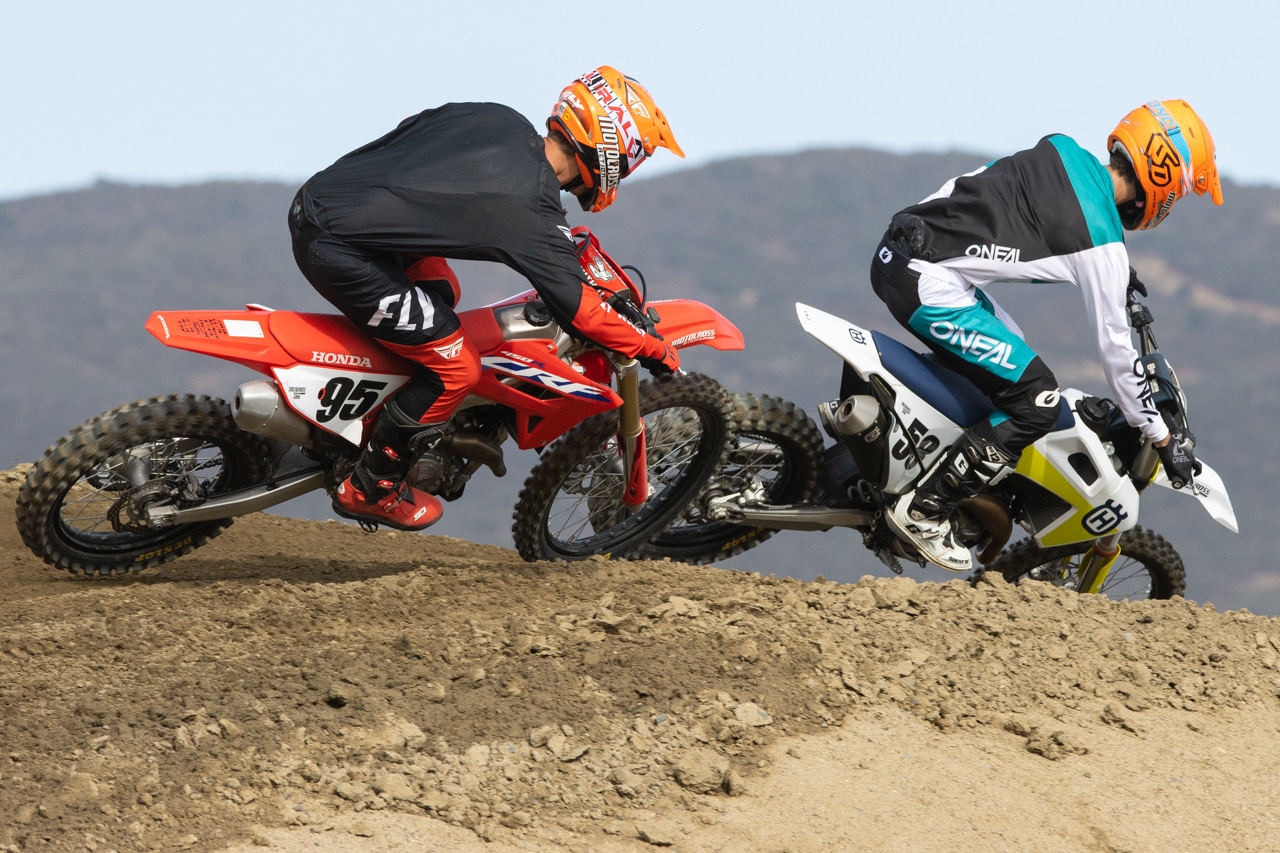

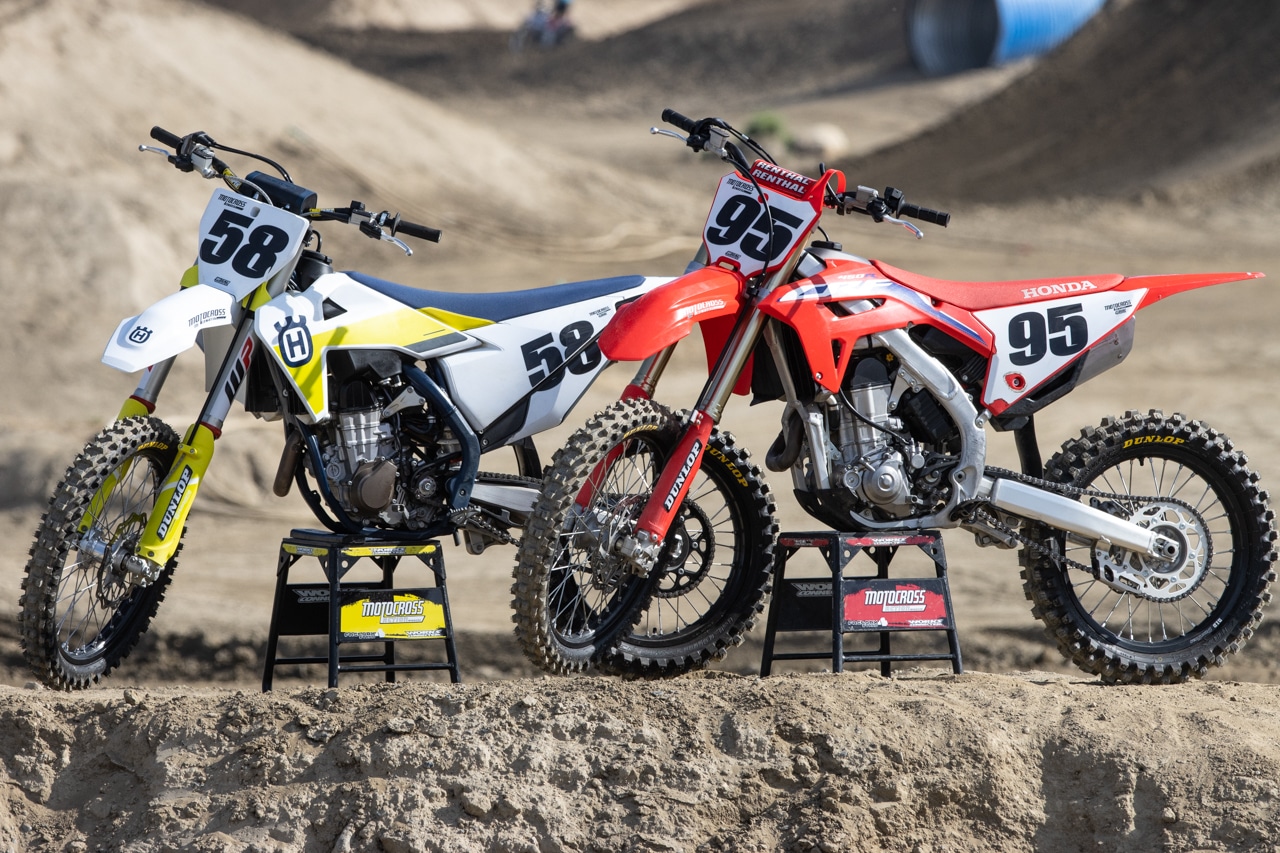
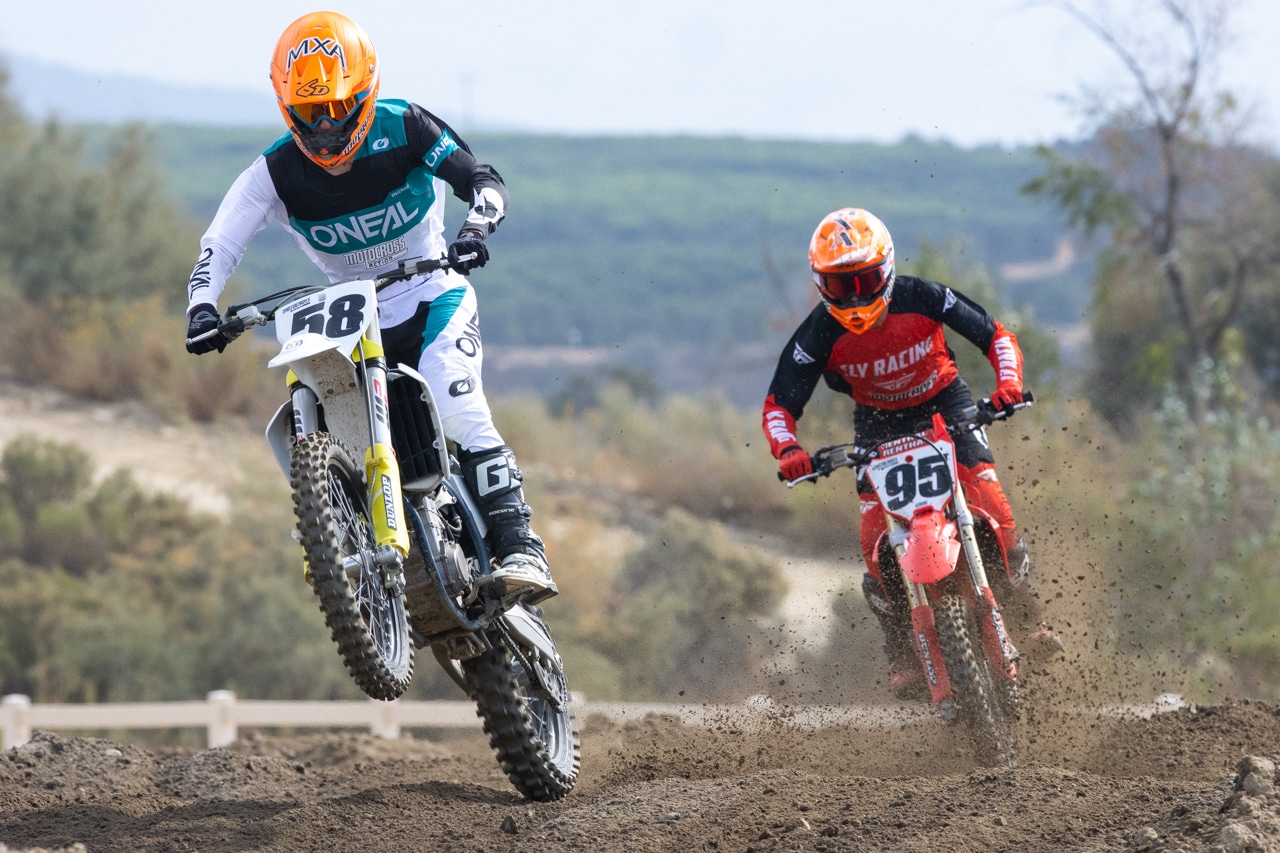

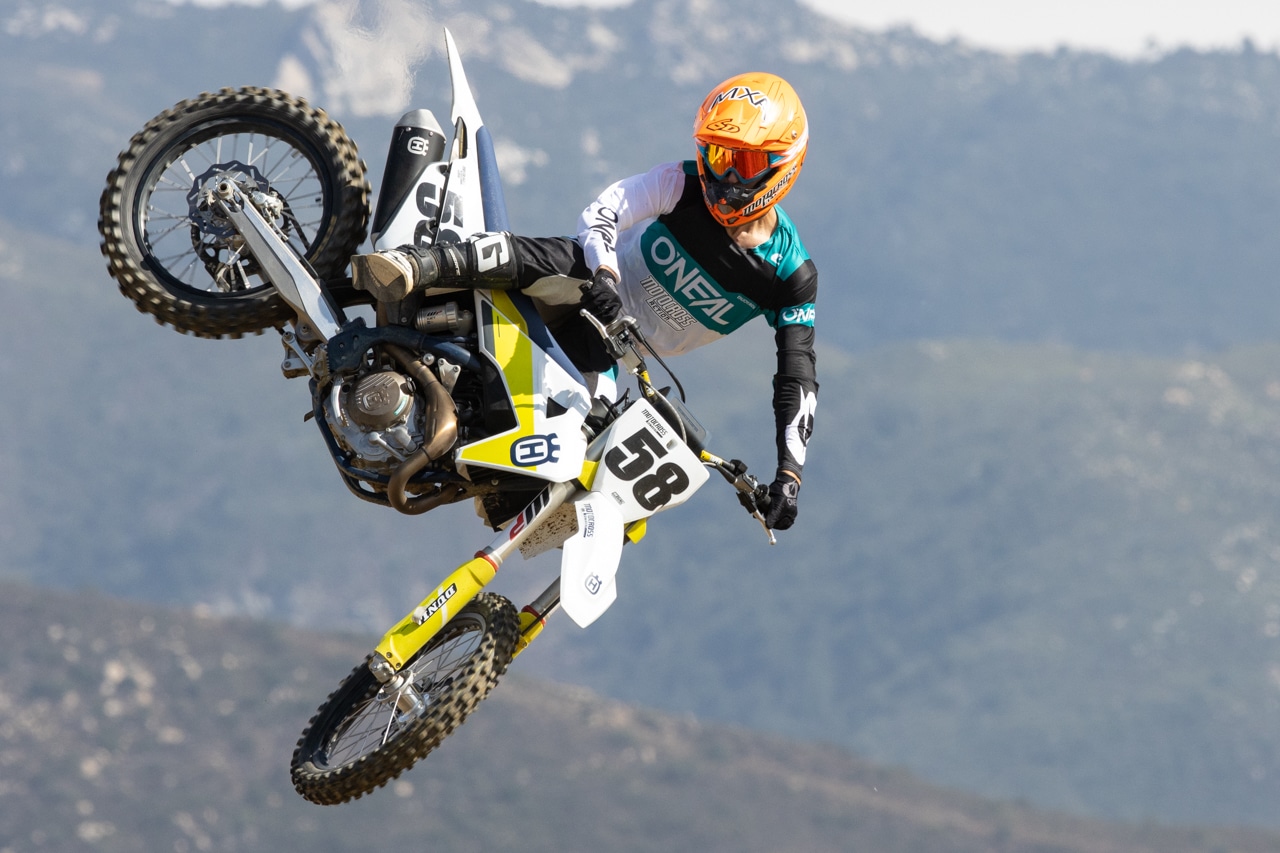
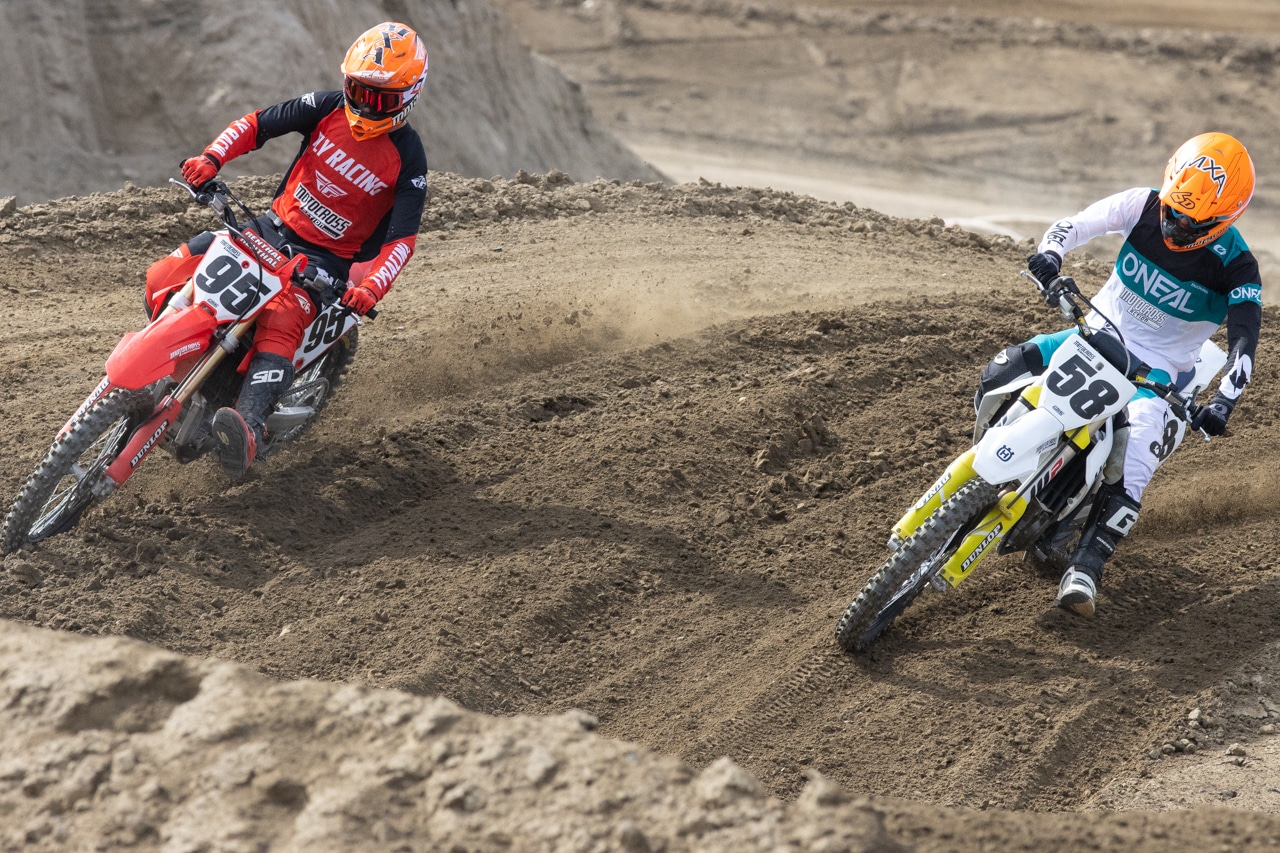


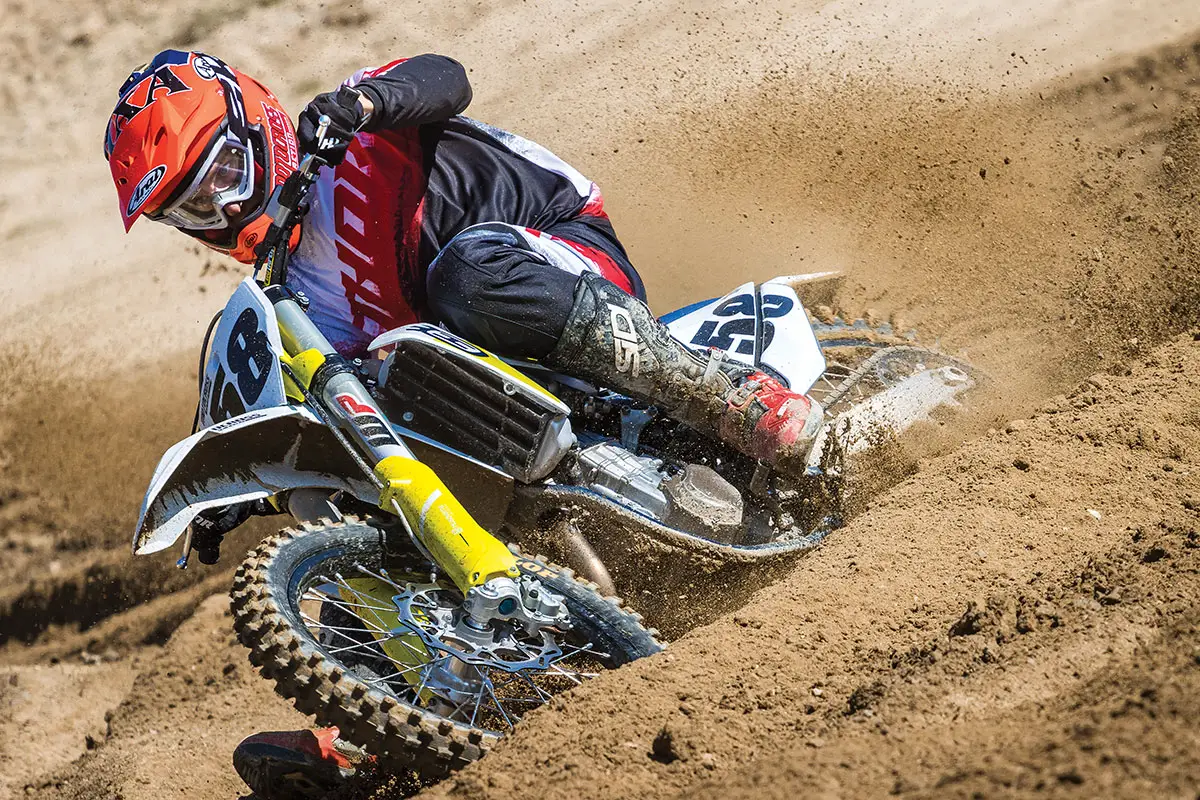



Comments are closed.